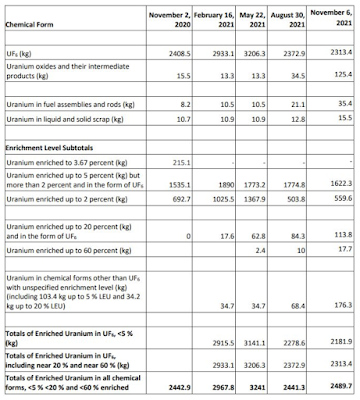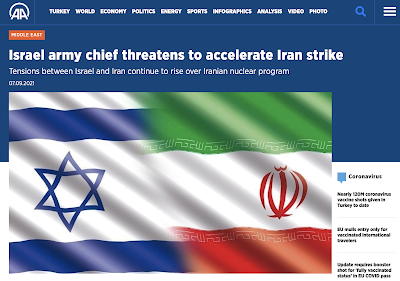Let's open this posting with a quote from General Kenneth McKenzie, commander of the U.S. Central Command from this article in Time Magazine about Iran's nuclear program and how it is progressing in the post-JCPOA period:
"Our president said they’re not going to have a nuclear weapon. The diplomats are in the lead on this, but Central Command always has a variety of plans that we could execute, if directed....They’re very close this time. I think they like the idea of being able to breakout.”
In this posting, we will look at a very recent report from the Institute For Science and International Security (ISIS) which analyzes the information provided in the International Atomic Energy Agency's (IAEA) quarterly Verification and monitoring in the Islamic Republic of Iran, the latest of which is dated November 17, 2021:
As background, under the terms of the Joint Comprehensive Plan of Action or JCPOA which went into effect in January 2016. Under the JCPOA, Iran agreed to not produce either rate highly enriched uranium or plutonium that could be used in a nuclear weapon (uranium enriched to 5 percent is used in nuclear power plants and 20 percent is used in research reactors or for medical equipment). The agreement limited the numbers and types of centrifuges that Iran could operate as well as the size of its stockpile of enriched uranium. Iran also agreed to implement protocols that would allow the IAEA to unfettered access to its nuclear facilities to prevent the nation from secretly developing nuclear weapons. U.S. President Donald Trump withdrew from the JCPOA on May 8, 2018, reinstating all previous sanctions that were removed as part of the deal with Iran and the P5+1 signatories. Since that time, Iran has taken steps to ramp up its nuclear program as shown in this quote from a backgrounder on the Council on Foreign Relations website:
"In response to the other parties’ actions, which Tehran claimed amounted to breaches of the deal, Iran started exceeding agreed-upon limits to its stockpile of low-enriched uranium in 2019, and began enriching uranium to higher concentrations (though still far short of the purity required for weapons). It also began developing new centrifuges to accelerate uranium enrichment; resuming heavy water production at its Arak facility; and enriching uranium [PDF] at Fordow, which rendered the isotopes produced there unusable for medical purposes.
In 2020, Iran took more steps away from its nuclear pledges, following a series of attacks on its interests. In January, after the U.S. targeted killing of a top Iranian general, Qasem Soleimani, Iran announced that it would no longer limit its uranium enrichment. In October, it began constructing a centrifuge production center at Natanz to replace one that was destroyed months earlier in an attack it blamed on Israel. And in November, in response to the assassination of a prominent nuclear scientist, which it also attributed to Israel, Iran’s parliament passed a law that led to a substantial boost in uranium enrichment at Fordow.
The following year, Iran announced new restrictions on the IAEA’s ability to inspect its facilities, and soon after ended its monitoring agreement with the agency completely."
Let's look at the aforementioned report by the Institute for Science and International Security. According to ISIS, the most recent report from the IAEA shows that the following progress has been made in Iran's nuclear enrichment program:
"Iran has enough enriched uranium hexafluoride (UF6) in the form of near 20 and 60 percent enriched uranium to produce enough weapon-grade uranium (WGU), taken here as 25 kilograms (kg), for a single nuclear weapon in as little as three weeks. It could do so without using any of its stock of uranium enriched up to 5 percent as feedstock. The growth of Iran’s stocks of near 20 and 60 percent enriched uranium has dangerously reduced breakout timelines.
Iran could continue producing more weapon-grade uranium, using its substantial stock of uranium enriched between two and five percent. In just over two months after the commencement of breakout, Iran could have produced enough additional WGU for a second weapon. After about 3.5 months, it would have enough for a third weapon. The additional production of enough WGU for a fourth weapon would be slower, taking six months, reflecting the depletion of Iran’s pre-existing stocks of enriched uranium.
Iran appears to have continued producing near 20 percent enriched uranium metal, although the IAEA does not provide details in its latest report. Despite Iran’s claims of civil use, uranium metal is a key material in nuclear weapons. Iran’s move to create the wherewithal to make uranium metal as well as making the metal itself is concerning because Iran is both instituting a nuclear weapons capability and increasing its knowledge and experience in this key area.
Iran experimented with using near 20 percent enriched uranium as feed in advanced centrifuges at the Natanz Pilot Fuel Enrichment Plant (PFEP), likely gaining important new knowledge in producing highly enriched uranium (HEU) using advanced centrifuges. This is also the first time Iran has started feeding a centrifuge cascade with uranium enriched more than 5 percent at any of its three enrichment plants, possibly gaining additional, irreversible knowledge in setting up and using equipment designed for smaller feed quantities and higher enriched uranium feed.
In essence, Iran is effectively breaking out slowly by producing 60 percent enriched uranium and continuing to accumulate it. As of November 6, Iran had a stock of 17.7 kg of near 60 percent enriched uranium (in uranium mass or U mass), or 26.1 kg (in hexafluoride mass). If Iran accumulated about 40 kg of 60 percent enriched uranium (U mass), it would have enough to be able to further enrich it and quickly produce 25 kg of weapon-grade uranium (U mass) in just a few advanced centrifuge cascades.
Alternatively, 40 kg of 60 percent enriched uranium is more than enough to fashion a nuclear explosive directly, without any further enrichment, although Iran’s known nuclear weapons designs use WGU.
Iran’s current production rate of 60 percent enriched uranium is 42 kg per year (U mass), meaning that it could accumulate its first amount of 40 kg in about 6.4 months, or by the spring of 2022."
Here is a table showing the growth in Iran's stockpile of enriched uranium:
The IAEA is most concerned about Iran's production of 60 percent enriched uranium (HEU) which began on April 17, 2021 which are not in line with its long-term enrichment and enrichment research and development plans submitted to the IAEA on January 16, 2016. Here is a quote from the ISIS report:
"During this reporting period, Iran continued to produce 60 percent enriched uranium, or HEU. This level of enrichment is associated with a key step in the traditional stepwise process of climbing from natural uranium to 90 percent enriched uranium, or WGU. Iran also instituted the production of HEU, albeit on a limited scale, by feeding 20 percent enriched uranium into a small number of IR-4 and IR-6 centrifuges.
Sixty percent enriched uranium can be used directly in nuclear weapons. About 40 kg (U mass) is more than enough to make a nuclear explosive, compared to the less than 25 kg (U mass) of 90 percent enriched uranium the Institute uses as sufficient for Iran to manufacture a nuclear explosive. Iran’s accumulation of 60 percent enriched uranium remains a highly provocative, dangerous step."
Moreover, the manner in which Iran has proceeded to enrich to 60 percent, starting from near 5 percent enriched material, is innovative, suggesting Iran continues to gain valuable experience in producing HEU, and by extension even WGU. It is practicing breakout under a civilian cover, and also learning to reduce the number of steps that it would need to go from natural uranium to WGU."
With the growth in Iran's stockpiles of 20 percent and 60 percent enriched uranium, the breakout timeline (the time required from Iran to produce enough enriched uranium for a nuclear weapon) has become "dangerously short". Given that 25 kilograms of weapon-grade uranium is required for a nuclear weapon, the ISIS report claims the following:
"Iran now has enough 20 and 60 percent enriched uranium to use as feed for the first 25 kilograms of weapon-grade uranium, producing about 10 kg of weapon-grade uranium from the 60 percent stock and 15 kg of weapon-grade uranium from the 20 percent stock. Each weapon-grade uranium stock can be produced in parallel, significantly reducing the timeline for production of 25 kilograms of weapon-grade uranium....
Currently, under the scenario outlined above, the result is that within about three weeks, Iran could produce its first quantity of 25 kg of weapon-grade uranium."
With this information in mind, one has to wonder how long it will be before both the United States and Israel take military action to destroy Iran's ability to further enrich its stockpile of uranium, dragging the world into yet another war, particularly given this:





I am reminded of the French saying
ReplyDeleteCet animal est très méchant,
Quand on l'attaque il se défend.
Trans
"This animal is very bad; when you attack it, it defends itself."
one has to wonder how long it will be before both the United States and Israel take military action to destroy Iran's ability to further enrich its stockpile of uranium, dragging the world into yet another war
I don't have a great deal of respect for the Washington foreign affairs mob, especially after the Trump regime effectively more than decimated the State Department but I hope the Chiefs of Staff manage to pound some sense into their heads.
If I understand Iranian policy, an all-out attack on their nuclear facilities will be considered declaration of war. That missile attack on an evacuated US base after the assassination of Generals Soliemani and Abu Mahdi al-Muhandis was a rather clear statement that Iran can hit any target in the Middle East. US bases in Qatar and the Horn of Africa are prime targets and Israel is a sitting duck especially as Hezbollah almost certainly will support Iran.
I suspect that if the USA is willing to engage in a long and costly war it could defeat Iran but is it really willing to bear the costs plus risk a world war?